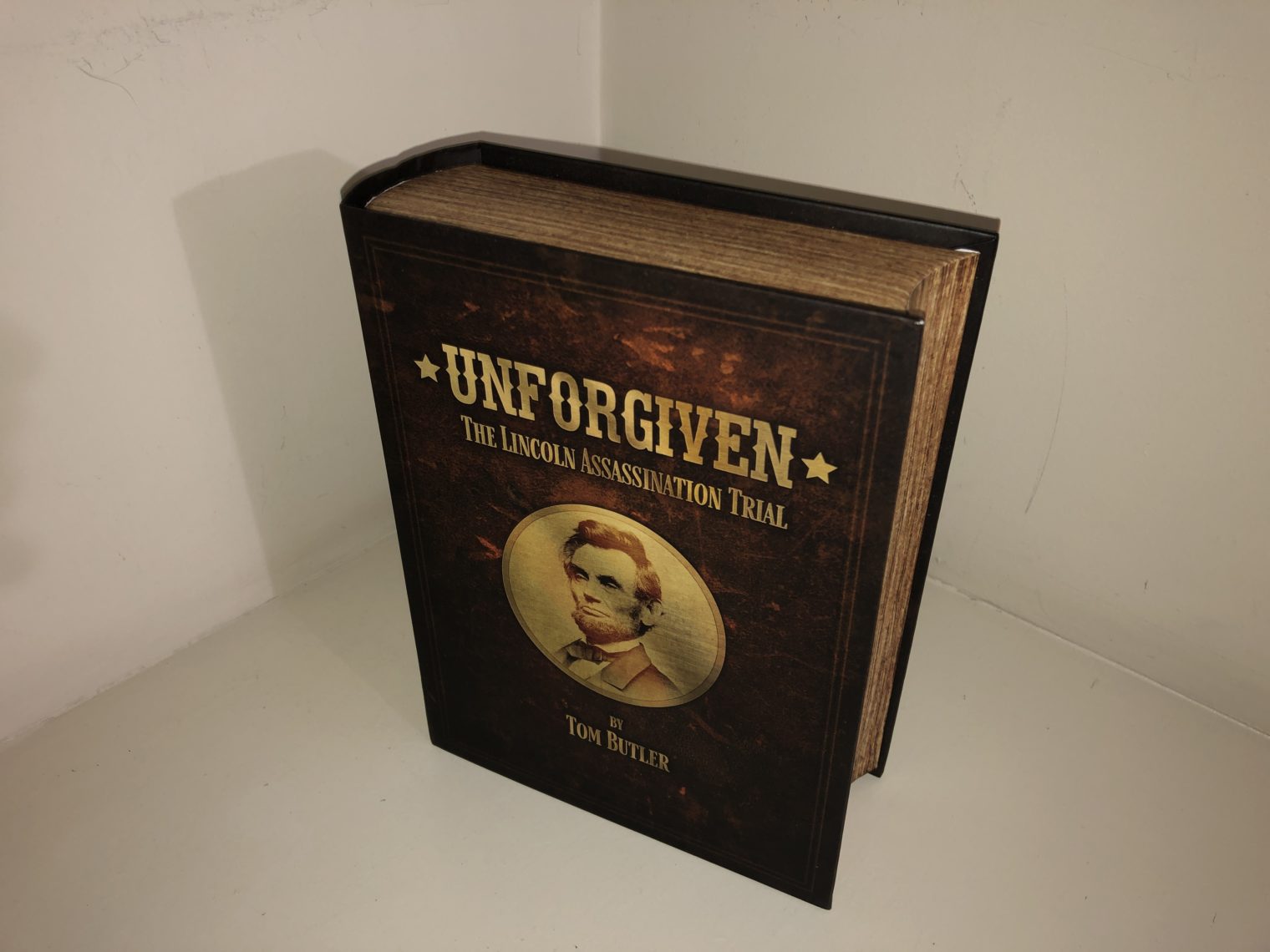Unforgiven’s title might mislead you into thinking it would be a game about frontier justice. It is actually about the trial of Mary Surratt, the first woman ever executed by the US government, for her alleged role in the assassination of Abraham Lincoln. Mary owned the boardinghouse where John Wilkes Booth and two other co-conspirators met to plan Lincoln’s murder, and in the thirst for vengeance for that crime she was sentenced to hang by a military tribunal. Now in Unforgiven you (well, one of you) gets the chance to change history. It’s a two-player courtroom drama with one player prosecuting and one defending.
I saw the game on BGG and was definitely intrigued because of the uncommon theme. Modern Tabletop is very thin on the ground when it comes to games set in the courtroom. 2016’s High Treason: The Trial of Louis Riel is really the only other one (I wrote about it here if you’re interested). Coincidentally (?) I was soon after contacted by its designer Tom Butler from Green Feet Games asking if I’d be interested in reviewing it. Butler clearly has a historical bent: his Patriots & Redcoats is a social deduction game set during the American Rebellion (er, War of Independence), and for 2021 he is planning another courtroom game about the 1925 court martial trial of WW1 air ace Billy Mitchell. I said, “Sure, send me a copy,” and here we are.
Because Unforgiven and High Treason are essentially in a class by themselves, I’m not going to be able to avoid comparing them. Both games come down to influencing members of the jury in several simultaneous tugs-of-war, but if High Treason’s gameplay owes much to the multi-use cards of Twilight Struggle and its descendants, Unforgiven’s inspiration is 7 Wonders: Duel with its card-drafting and tableau-building mechanics, plus a weensy bit of die-drafting. This gives Unforgiven a more streamlined feel at the expense of some realism–and there is plenty of strategic and tactical depth to engage both sides.

Each player starts the game with two random jurors “in hand” both literally and procedurally, the idea being that they are already on your side and ready to be convinced (ie deployed to your tableau). Three more are dealt to the middle of the board, where they will see-saw back and forth, and the final two are “deadlocked”–one unlockable by each side if and when they make a convincing enough case overall as measured by the Justice marker (which operates very much like the Military marker in 7 Wonders: Duel). Deployed jurors confer pretty sweet benefits, either instant or ongoing, including taking extra turns, which (like 7WD) can snowball into pretty awesome combos.
The three phases of the game (which unlike High Treason have no legal counterparts, they’re just “phases”) each start by dealing a display of cards which will be drafted by the players. Like 7WD some are face-up, some face-down, and overlap so that only completely uncovered cards can be drafted; unlike 7WD, the diamond-shaped display is the same for all three ages phases. Then each side starting with the prosecution gets to draft a Trial die from a display. Trial dice supply different resources you need to play cards, sway/convince jurors, or move the Justice marker toward your side of the board. They’re crucial in the early game as you get your “argument engine” going, and later on can supply crucial VP as well.
Once the dice are drafted players take turns removing cards from the display and taking an action; they can also trade Trial dice in for optional special actions. Once the display is emptied the Phase is over and things start over again for the next Phase–unless it’s the end of Phase 3, in which case VP are totalled and the player with the higher amount wins. Or, cue dramatic music, the game can end instantly if one player convinces four jurors or moves the Justice marker off their end of the track.

Players have to fight on multiple fronts and can’t afford to ignore any of them. Conversely, a player who falls behind can, through misdirection and bluffing, turn things around. I can’t comment on the components definitively because I had an advance copy, but the iconography and artwork on the cards were clean and uncluttered, and the rules were clear and unambiguous. The box is designed to look like a thick book, which is neato but a tiny bit too small for all the components for the lid to stay shut, and it’s not a standard size either so a little hard to find a place on the shelf for it. Maybe put it on your bookshelf instead?
All in all I really enjoyed Unforgiven for how it gamified the cut and thrust of a courtroom. Mind you, it’s a game, not a simulation, and High Treason gets a little more down and dirty into actual trial procedure.
If like me you’re a history buff who doesn’t mind some sacrifice to gameplay, or if you enjoy 7 Wonders Duel and are looking for something similar but slightly more complex, then I can definitely recommend Unforgiven. Let’s put it this way: I have to send back my review copy, and I am backing it on Kickstarter. That’s how much I want to have a copy of it. And I look forward to Butler’s next efforts.
The Kickstarter campaign for Unforgiven ends October 31. Thanks to Green Feet Games for providing a review copy for this article.
Comments
No comments yet! Be the first!